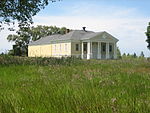Discovery Park (Seattle)

Discovery Park is a 534-acre (2.16 km2) park on the shores of Puget Sound in the Magnolia neighborhood of Seattle, Washington. As the city's largest public park, it contains 11.81 miles (19.01 km) of walking trails. Daybreak Star Cultural Center is within the park's boundaries. A lighthouse is located on West Point, the westernmost point of the park and the entire city of Seattle, and on the south side of the North Beach strip is a sewage treatment plant, but it is almost entirely concealed from the marsh, beach, and trail. The Discovery Park Loop Trail, designated a National Recreation Trail in 1975, runs 2.8 miles (4.5 km) through the park, connecting to other trails.The park is built on the historic grounds of Fort Lawton; most of the Fort Lawton Historic District (FLHD) falls within the park (although an enclave within the district remains in military hands), as does the West Point Lighthouse. Both the FLHD and the lighthouse are on the National Register of Historic Places. Forests, beaches, prairies, and bluffs dominate the landscape of the park.
Excerpt from the Wikipedia article Discovery Park (Seattle) (License: CC BY-SA 3.0, Authors, Images).Discovery Park (Seattle)
Dakota Avenue, Seattle Magnolia
Geographical coordinates (GPS) Address Nearby Places Show on map
Geographical coordinates (GPS)
| Latitude | Longitude |
|---|---|
| N 47.658333333333 ° | E -122.41888888889 ° |
Address
Dakota Avenue
Dakota Avenue
98199 Seattle, Magnolia
Washington, United States
Open on Google Maps










